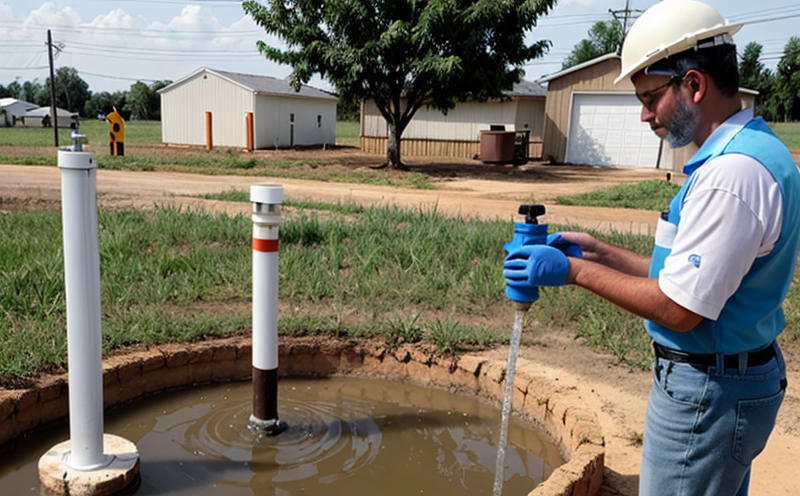ISO 8245 Conductivity Testing of Groundwater
The ISO 8245 standard provides a comprehensive framework for the measurement and interpretation of conductivity in groundwater. Conductivity is a key parameter that reflects the presence of dissolved salts, metals, acids, bases, or other ions in water. This test is essential for ensuring compliance with regulatory standards and safeguarding public health.
Groundwater forms an integral part of our global freshwater resources. It plays a pivotal role in agriculture, industry, and domestic use. The quality of groundwater directly impacts the safety and sustainability of these sectors. Conductivity testing helps to identify contamination sources such as agricultural runoff, industrial discharges, or accidental spills. By adhering to ISO 8245, laboratories ensure that their results are accurate, reliable, and comparable with international standards.
The process involves collecting groundwater samples from various depths within a well, ensuring proper sample preservation, and transporting them under controlled conditions to the laboratory for analysis. The testing equipment includes conductivity meters calibrated according to ISO 8245 specifications. These meters measure the electrical conductivity of water solutions by passing an alternating current through it.
The results are compared against acceptance criteria specified in ISO 8245, which vary depending on the intended use of the groundwater. For instance, drinking water must meet stringent limits to ensure safety for human consumption. Agricultural and industrial uses may have less strict requirements but still need to comply with regional regulations.
Compliance with ISO 8245 is crucial not only for regulatory adherence but also for maintaining a good reputation among stakeholders. Clients appreciate laboratories that demonstrate commitment to high-quality testing practices, which can lead to increased business opportunities and long-term partnerships.
In conclusion, ISO 8245 conductivity testing of groundwater is vital for protecting public health and the environment. By providing accurate measurements and interpretations, this service ensures that water resources are used sustainably and responsibly.
Why Choose This Test
Selecting ISO 8245 conductivity testing offers numerous advantages to various stakeholders involved in groundwater management:
Quality Managers: Conductivity tests help monitor the quality of groundwater over time, ensuring consistency and meeting regulatory requirements.
Compliance Officers: By adhering to international standards like ISO 8245, laboratories can demonstrate their commitment to regulatory compliance, reducing potential legal risks.
R&D Engineers: This test provides valuable data for developing new technologies and improving existing processes related to water treatment and management.
Procurement Departments: Reliable conductivity testing ensures that purchased groundwater meets necessary quality standards before being integrated into larger systems or projects.
The precision and accuracy of ISO 8245 results enable stakeholders to make informed decisions based on real data, fostering trust and confidence in the integrity of the laboratory's services.
Customer Impact and Satisfaction
Adopting ISO 8245 conductivity testing has a significant positive impact on customers' experiences:
Increased Confidence: Clients gain confidence knowing that their groundwater quality is being assessed using internationally recognized standards.
Improved Decision-Making: Accurate and reliable data facilitate better decision-making in water resource management, leading to more efficient operations.
Better Reputation: Demonstrating adherence to rigorous testing protocols enhances the laboratory's reputation among clients, stakeholders, and regulatory bodies.
Enhanced Relationships: Satisfied customers are more likely to recommend the service to others, fostering stronger relationships within the industry.
These benefits contribute to overall customer satisfaction and loyalty, which is crucial for sustained business growth and success.
Use Cases and Application Examples
| Application Example | Description |
|---|---|
| Agricultural Irrigation | Determining the suitability of groundwater for irrigation purposes based on its conductivity level. |
| Industrial Processing | Evaluating the quality of water used in industrial processes to ensure it meets specific conductivity requirements. |
| Water Treatment Facilities | Monitoring the effectiveness of treatment processes by measuring changes in conductivity over time. |
| Environmental Monitoring | Tracking the impact of pollution on groundwater quality through regular conductivity testing. |
| Drinking Water Supply | Ensuring that drinking water meets stringent health and safety standards by measuring its conductivity. |
| Sustainable Resource Management | Developing sustainable management strategies for groundwater resources based on conductivity data. |
| Regulatory Compliance | Maintaining compliance with local, national, and international regulations regarding water quality. |
These use cases highlight the versatility of ISO 8245 conductivity testing across different sectors. The consistent application of this standard ensures that all stakeholders receive accurate and reliable results, promoting best practices in groundwater management.





